59 Traditional English foods to try
British foods don’t often bring to mind a gourmet treat but there are some classic English foods that we do miss from our childhoods. This is part of the reason I love house sitting in England the chance to have all my old childhood English foods as well as heading out to some of the best farmer’s markets and market towns in the world.
When I think of my favourite food in England – things like fish and chips or a roast beef Sunday lunch come to mind but there are certain traditional English foods that make me smile because of the memories attached to them.
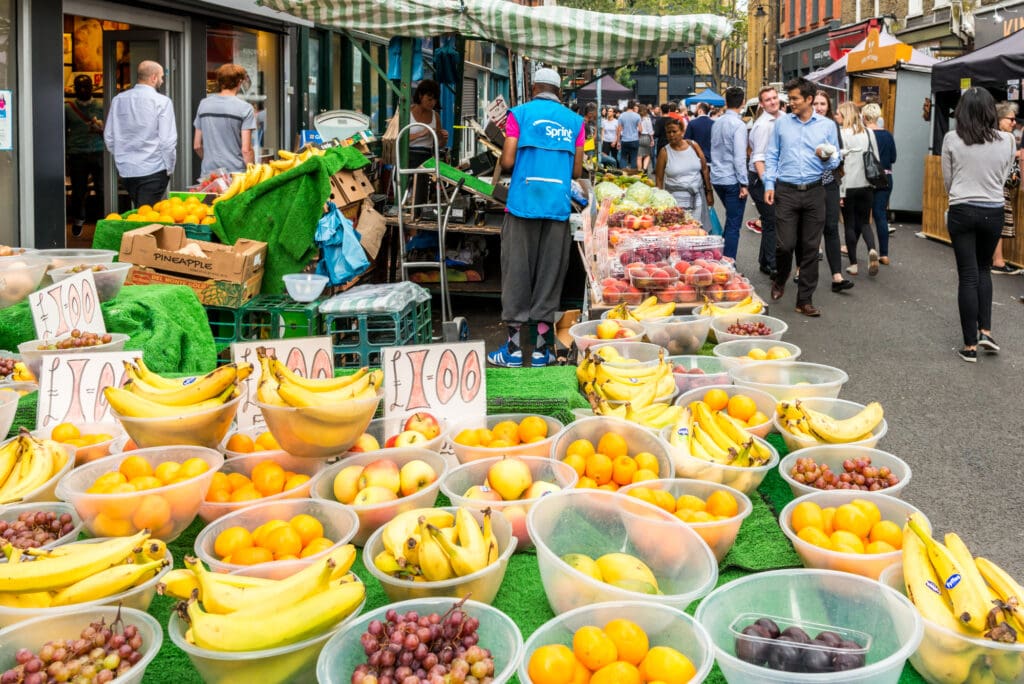
The English had a reputation for some of the worst cooking in the world and my mother is proof of that. It used to be that the English boiled the crap out of everything and when it was served all the food was the same grey mess. And then there were those quirky British dishes that defied explanation. English meals have come a long way in the past 30 years.
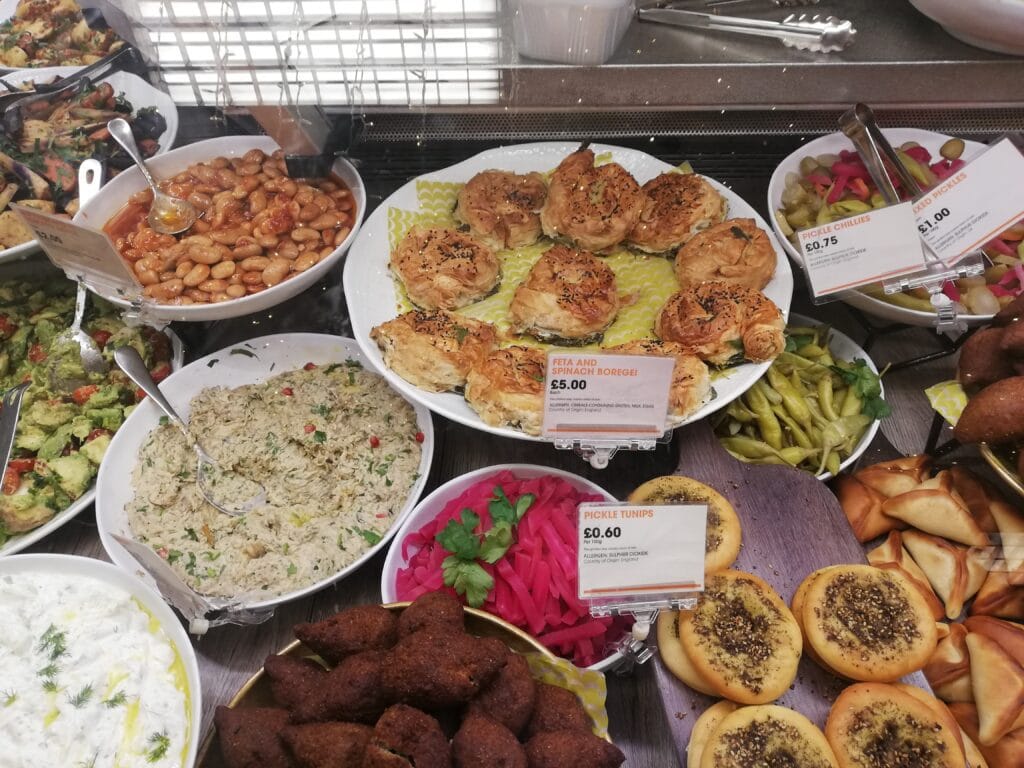
Well, that was then and now England has a reputation for some of the finest foods and finest food halls in the world. However, there are some old favourites that the British cling to and rightly so. These are some of the famous English food dishes to try if you visit England. Many of you may already be a fan of some of these stalwart English meals – I know my family can’t resist a Toad in the Hole.

But, and there always is a but, England is also home to some of the weirdest foods many of which were my childhood favourites and some which I wouldn’t touch with a barge pole. Certain traditional English foods can be a tad off-putting. So for your dining pleasure here is my list of the top 59 British dishes you must try.
Book a Great British Tea Bus Tour here
- 59 Traditional English foods to try
- Top 59 English Dishes
- 59 Traditional British dishes you may want to try
- Roast Dinner
- Paste
- Pie in a tin
- Saveloy and chips
- Chips with Curry Sauce
- Pie, mash and liquor
- Jellied Eels
- Winkles
- Whelks
- Cockles
- Black pudding
- White pudding or oatmeal pudding
- Mushy and marrowfat peas
- Battered sausages
- Scotch Eggs
- Manchester Eggs
- Toad in the Hole
- Marmite
- Piccalilli
- Branston Pickle
- Pickled eggs
- Chip butties
- Parmo
- Singing hinny also known as Stotty cake
- Hindle Wakes
- Spotted Dick
- Traditional English Trifle
- Eton Mess
- Chelsea buns
- Melton Mowbray pork pie
- Bakewell tart
- Bedfordshire clanger
- Lancashire hotpot
- Cumberland sausages
- Eccles cake
- Cornish pasties
- Hog's pudding
- Maids of Honour tart
- Coventry God cakes
- Staffordshire oatcakes
- Pease pudding
- Panackelt
- Parkin or Perkin cake
- Potted shrimp
Xyuandbeyond is reader-supported. When you buy through links on our site, we may earn an affiliate commission. You can read my privacy policy here.
Top 59 English Dishes
English traditional foods can be – hmm – well shall we say unusual in other countries. For example in Canada, we wouldn’t dream of trying a meat pie from the tin and when I mention Toad in the Hole to friends they give me that “oh no here comes some weird food” look. Foraging has always been a part of my British food memories. Picking wild blackberries, gathering rose hips and scouting for mushrooms was always fun when I was a kid. These days responsible foraging is growing and there are many organizations that will teach you how to forage.
These are some pretty traditional foods in England. How many have you ever had?
The following list of 59 British foods some of which may sound weird or unappetizing to those of you who haven’t been to England, but give them a try you never know you may just like them.
Book your Secret British food tour here
59 Traditional British dishes you may want to try
Roast Dinner
What can you say about a traditional Sunday lunch in the U.K? A plate full of roast beef, roast pork, lamb, turkey or chicken loaded with freshly cooked veg and yes that includes Brussels sprouts. Lots of gravy, roastie potatoes, Yorkshire pudding and possibly stuffing.
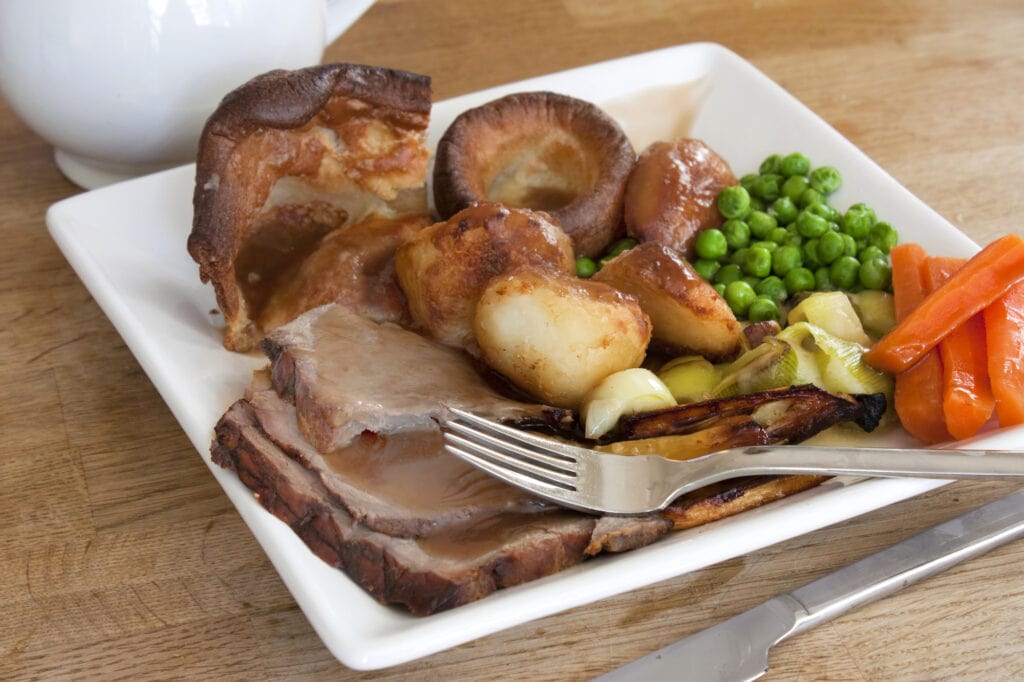
All the traditional accompaniments from horseradish, cranberry sauce, mint sauce, apple sauce can be added to your already bulging plate of food – and then an afternoon nap – heaven.
Paste
I know it doesn’t sound appetizing but I loved this stuff as a kid and I still slather it on toast or a sarnie when I need a comfort snack. They come in a variety of flavours: Sardine and Tomato, Salmon, Bloater and a few others these are my favourites though. This is the dictionary definition of English Paste. Paste: a thick, soft, moist substance typically produced by mixing dry ingredients with a liquid. “blend onions, sugar, and oil to a paste”

Pie in a tin
Specifically Fray Bentos Steak and Kidney pie. Lever off the lid and pop this into the oven and it doesn’t look too bad once the pastry crust starts to fluff and turn golden. However, upon its release from the oven and an attempt to serve on a plate, all your illusions of lovely steak and kidney turn to ashes because there really isn’t any in this pie merely some gluey gravy, nasty slimy undercooked pastry and tiny little pieces of some kind of meat. Exactly what I remembered LOL and kinda tasty anyways.

Saveloy and chips
oh on the drunken nights wandering home from the pub absolutely skint broke and needing some greasy food to sop up the alcohol. Meal of choice you ask? Saveloy and chips a load of lovely hot cooked chips smothered in salt and then Sarsons Malt vinegar alongside a rather large tube of meat encased in an orangey skin – the saveloy.
Best when eaten drunk with ketchup the saveloy is merely a hot dog by another name, around 12 inches long and thicker than the average dog and of course, made of pork, it is rather a bland tube meat but does the job of soaking up some beer.
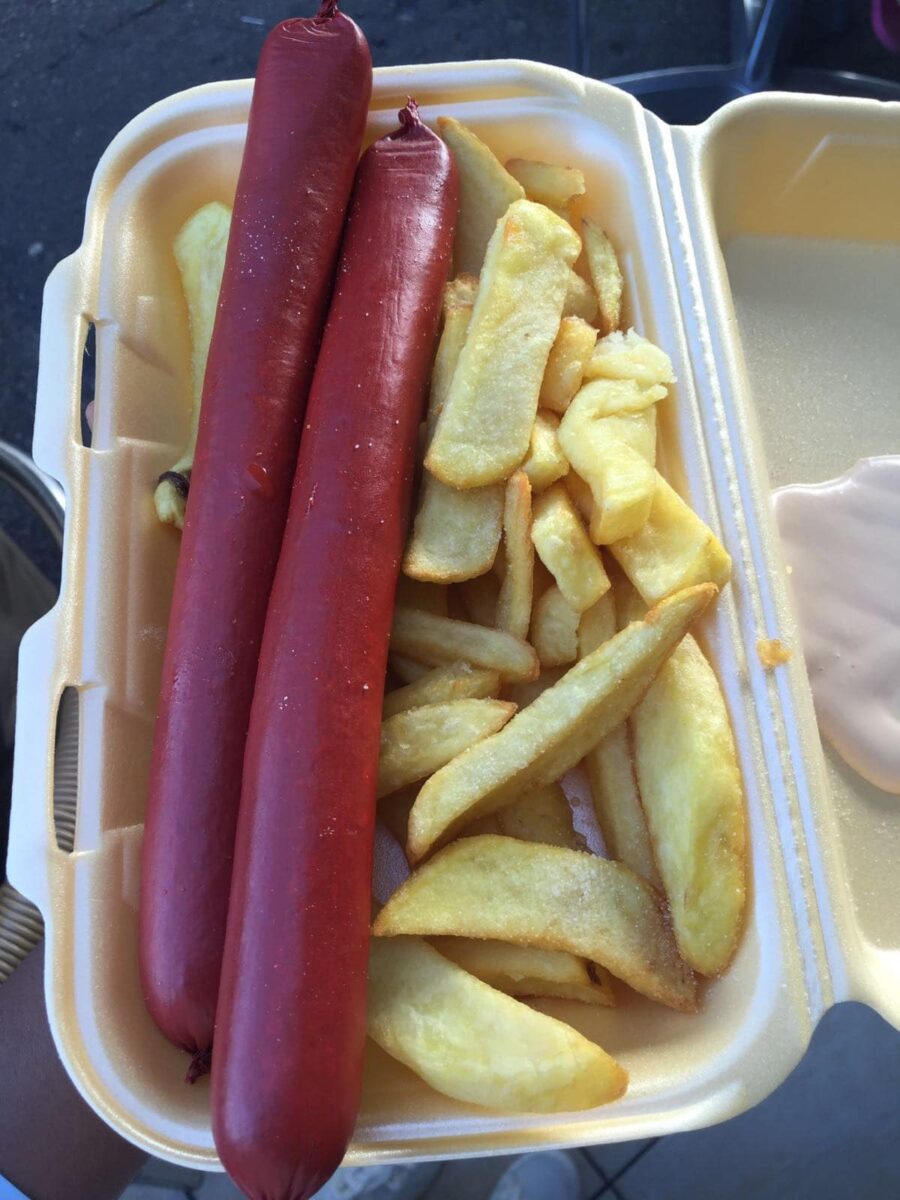
Chips with Curry Sauce
Another treat to soak up the alcohol. Screaming hot chips with a creamy curry sauce slathered on top. So popular that you can now buy a myriad of curry sauce versions to make your own at home. This sauce probably first invited the English to try curries and thank god for their taste buds (well some of them) have evolved since that point.

Pie, mash and liquor
No not alcohol but the “gravy” that is always served as Piemashliquor, which is exactly what it says a meat pie, mashed potatoes and the liquor is the green thin liquid splashed on top of this tasty treat that fuelled many a working person in the East end of London.
Liquor is said to be the traditional water in which jellied eels were cooked, parsley is then added and a greenish thin liquid is a result. This liquor is then poured over your mash and pie and seems to some to be quite enjoyable. I always thought it smelled funny and never tried it.

Jellied Eels
That, of course, brings me to jellied eels, one of the more traditional British dishes and it could truly be considered the national dish of England (if you live in the East end) – jellied eels are to me absolutely revolting. Chunks of silvery eel coated in slimy gelatin. In the 18th century, native eels were plentiful in the River Thames and estuary, and Dutch eel barges and fishmongers a common sight.
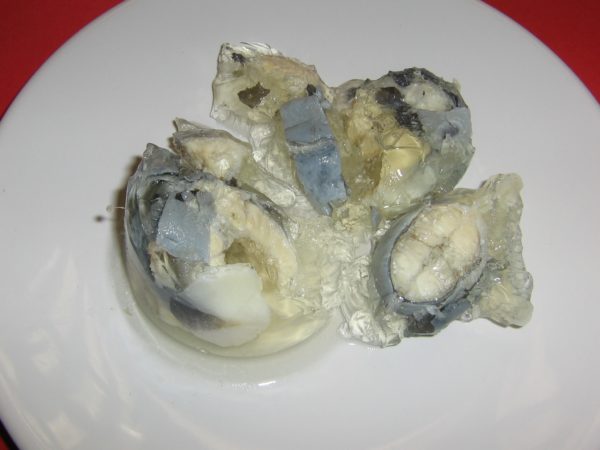
One cheap and easy preparation, particularly among the East End working-class poor, was to chop the eels, boil them in herbs, and then allow them to cool; the eels would produce enough of their own gelatin so that a soft jelly would form around the pieces. (Today, a bit of gelatin is often added.) They say the taste is mild and salty but not fishy but you would have to get past the nasty look of them and all that jelly.
Winkles
Sigh…another East-end favourite – tiny minute sea snails that you have to use a pin to dig out the meat and dip in hot butter or garlic mayonnaise. Alan ate these in Brittany but said they didn’t have much flavour apart from the salty, garlicky butter that they were cooked in.
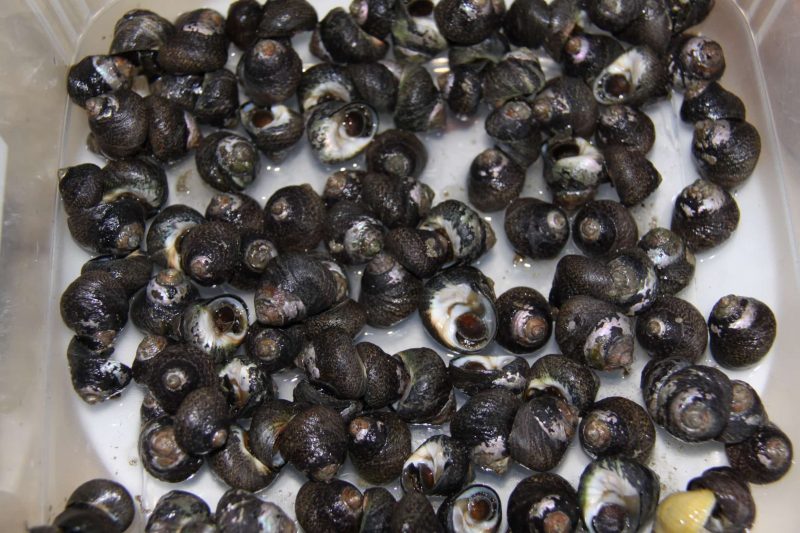
Whelks
Whelks are fat sea snails they’re cheap and lend themselves well to all sorts of flavours. Chefs these days are adding them to all kinds of seafood stir-fries and they are becoming very trendy in the upper echelons of British restaurants.

Cockles
A type of tiny clam with the distinctive ridged shell you commonly see on British beaches. They are steamed like other clams and added to a dish or simply served with a dash of salt. Another of those traditional English foods that is seeing a return to favour with Chefs all over the country.
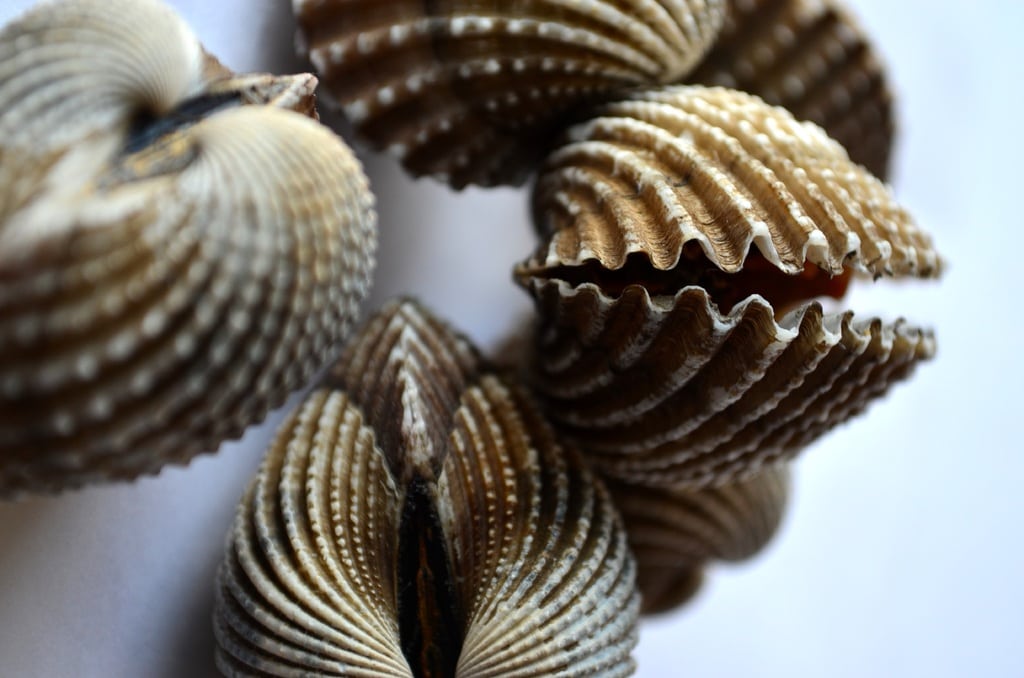
Black pudding
My husband’s favourite especially when served with a Full English or Irish breakfast, I have to say it does nothing for me. Blood sausage is exactly that – pig’s blood is collected, mixed with some herbs and a little oatmeal or binder pushed into a large sausage skin and served fried with breakfast.
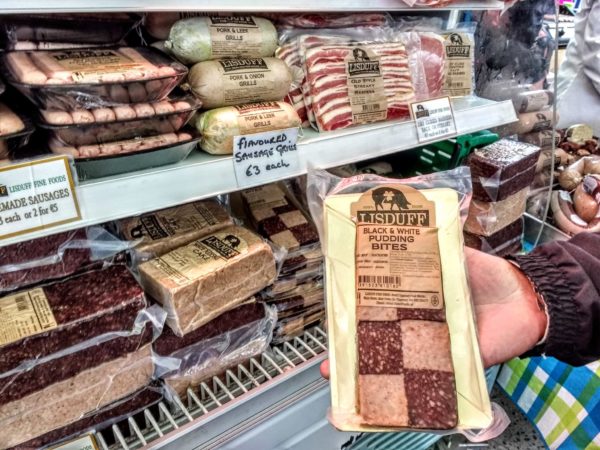
White pudding or oatmeal pudding
This is another very traditional English food favourite. Like black pudding in size, it is a creamy white appearance but is made of pork meat and fat including lots of suet and oatmeal. Some areas have spiced it up with black pepper, and herbs but it still tastes like it is a sausage made out of fat.
Mushy and marrowfat peas
Oh, I remember my Bachelor’s tinned peas with great fondness. I hated those fresh frozen green spring peas we got in Canada and vowed to never eat peas again. On my return to the UK, the first thing I bought was a tin of marrowfat peas. Marrowfats are green mature peas that have dried on the vine, it is a starchy kind of pea that is soaked overnight and then cooked with sugar, salt and a little bicarb of soda.
They can be found dried in many Canadian grocery stores but here in the UK, there is always a quick-cook canned kind that I remember fondly from my childhood. Marrowfats also make mushy peas which are the perfect side dish for fish and chips.
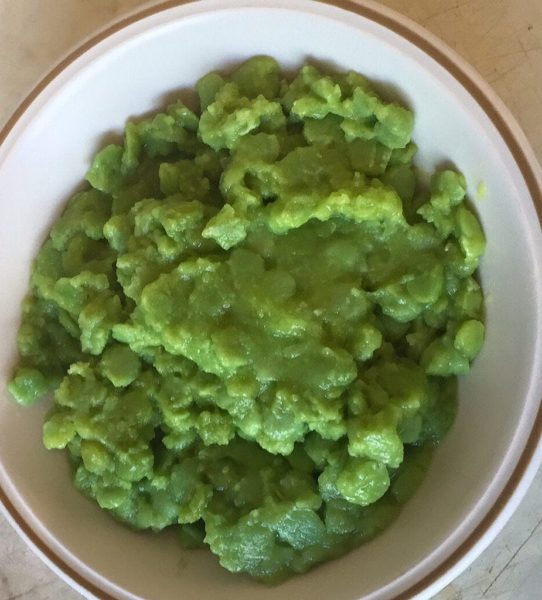
Battered sausages
It is what it is a cheap sausage; cooked, battered with the same stuff they use on the fish and then deep-fried. Not a particularly gourmet treat but cheap and available in every chippie anywhere in the British Isles.
Here in England, there is a great fondness for battered and fried foods of any description from the famous fried Mars bars to everything in between. Another area of British foods that I just can’t get my teeth into.
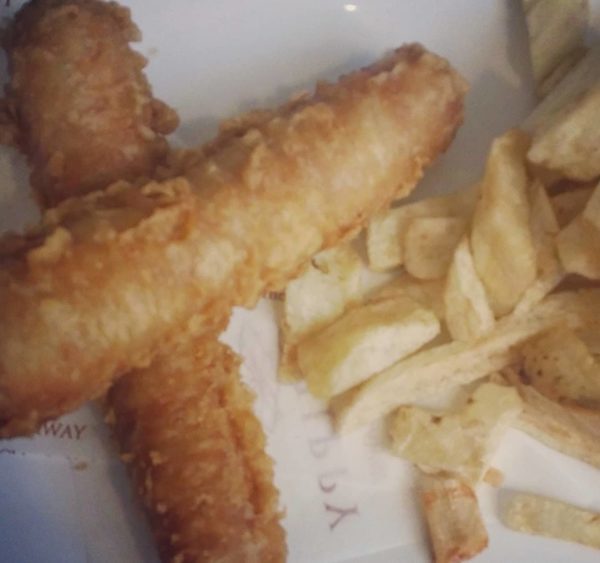
Scotch Eggs
My most favourite treat in the world. These days these things have gone right upmarket and are even sold in Harrods no less. A hard or semi-hard boiled egg (lovely when the yolk is runny) is coated in tasty sausage meat, then rolled in breadcrumbs or oatmeal and deep-fried till golden. A warm Scotch egg tastes like nothing else when that gorgeous orangey yolk bursts over your plate. A cold Scotch egg is the perfect picnic treat, or midnight snack oh hell anytime.
This traditional English food is just that English, not Scottish, it is believed they were invented by Fortnum & Mason’s for picnics to be taken to the Ascot races.

Manchester Eggs
A variation of the Scotch Egg found in Manchester obviously. This uses a pickled egg which is then rolled in black pudding and sausage meat and deep-fried.
Toad in the Hole
Warning contains no toads and no holes unless you count the deep ditch in your pan of Yorkshire pudding that the sausages nestle in. I know I complained about battered sausages above but Yorkshire pudding is not mere batter. Yorkshires are cooked in hot fat and roast juices and rise on the edges like a heavenly pillow. Served with good gravy, mash and cabbage my family’s favourite English dinner – say no more.

Marmite
A cracker spread like no other. Made from a yeast extract it is sticky, smelly and a dark brown with a very distinct taste some have named umami. It is super salty and loads of vegetarians are using it these days as an ingredient, also note that the Australians have a version called Vegemite.
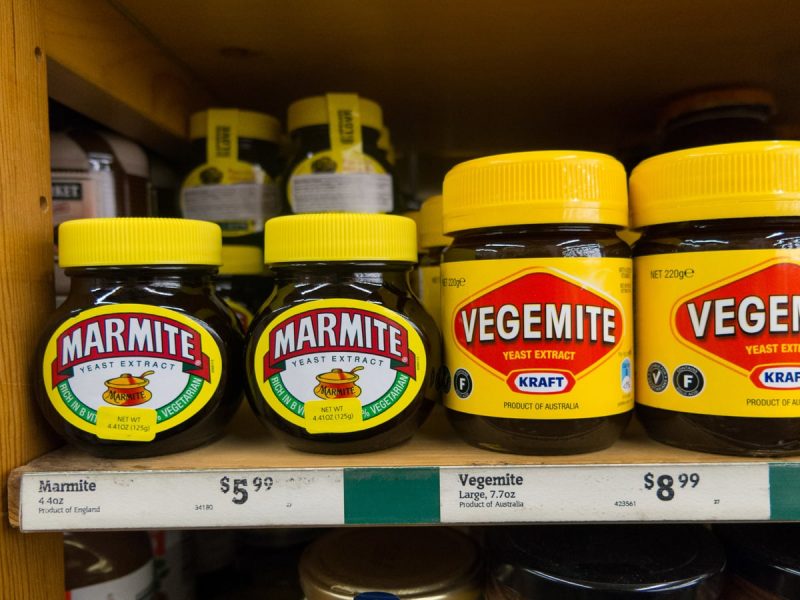
Apparently, a “marmite” was a covered earthenware pot, my guess is that is what it used to be cooked in or was dumped in after the beer had finished brewing. I’m not sure why this is such an English traditional food – its yeasty, salty soy sauce sort of flavour does nothing for me.
The early 20th Century saw Marmite become a classic British savoury treat as it was included in World War One rations. It would remain popular among troops and civilians alike in World War Two and beyond – it was sent out to homesick British troops in Kosovo in 1999.
Piccalilli
I love that name so British. This is a mustard-based veggie pickle that if god forbid it doesn’t include cauliflower it is not authentic Piccalilli. It is sharp and mustardy and coloured with turmeric and it is the best pickle to have with pork pies and cold ham.

Branston Pickle
Best served with a Ploughman’s Lunch, good cheddar and thick slabs of ham. Branston is a pickled chutney-based product that always includes swede (also known as rutabaga or turnip), carrots, onions and cauliflower. The sauce is made from sugar, tomato, spices and vinegar. It is sweet and sticky and can be bought with a small chunk or a large chunk – heaven with a good cheese sandwich or a Ploughman’s Lunch.
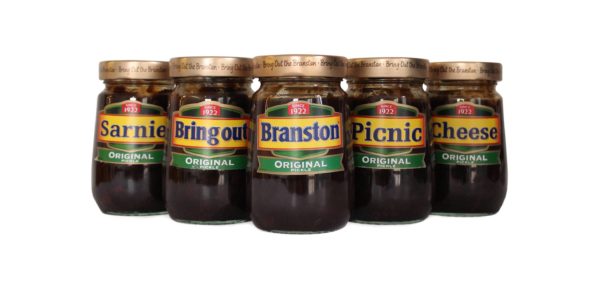
Pickled eggs
Are seen in every chippy which might indicate that they are good for those already pickled with alcohol (that’s the only time my hubs eat them). They are hardboiled eggs, pickled in brine or mainly in Malt vinegar with sugar, salt and occasionally some spices and herbs are added to gourmet them up a bit. My guess is that they used to preserve eggs this way centuries ago.
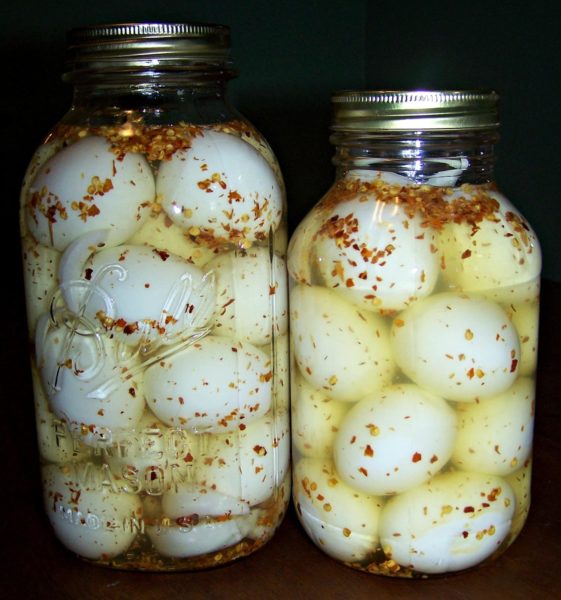
Chip butties
My favourite treats in the world, white bread just slathered with butter (Kerrygold Irish butter springs to mind here) then stuffed with fresh crispy chips doused in malt and salt. The resulting mess is stuffed into your mouth and enjoyed for its pure and simple taste, nothing better.

Parmo
A very traditional Northern style treat after an evening of drinking. The famous Teeside Parmo hails from Middlesborough is basically a chicken parmesan cutlet served in a box with chips. Nothing unusual in that, but apparently was brought to the area by an American serviceman who stayed in the UK after WWII. Apparently, the Grand Central Food Bazaar does a primo one as well.
Singing hinny also known as Stotty cake
This hails from Northumberland and is a scone-like griddle cake made with flour, butter, lard, currants, salt and milk.
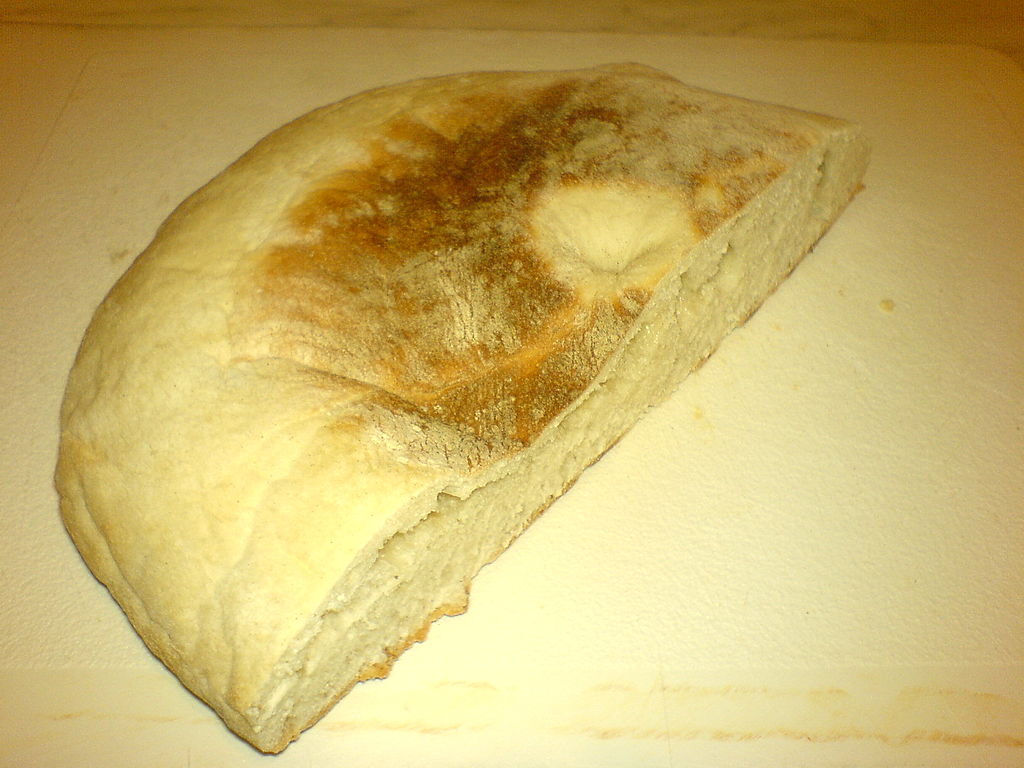
Hindle Wakes
From Lancashire, this uses a boiling chicken that is stuffed with prunes then steamed and served with a lemon sauce.
Spotted Dick
Ah, the great traditional English pud Spotted Dick is a very dense thick pudding made of suet, flour lots of sugar and dotted with currants. The pudding is boiled for hours and served with custard.

Traditional English Trifle
A pretty multilayered concoction Trifle includes Ladyfinger biscuits or sponge cake soaked in sherry and usually tinned fruit then topped with jelly, custard, and cream. It’s a very pretty layered dessert that looks great and to some tastes wonderful but it was never my favourite that soggy cake was quite off-putting.

Eton Mess
A traditional dessert from Eton is basically crushed meringue mixed with jelly and canned fruit and lots of cream, in other words, a mess.
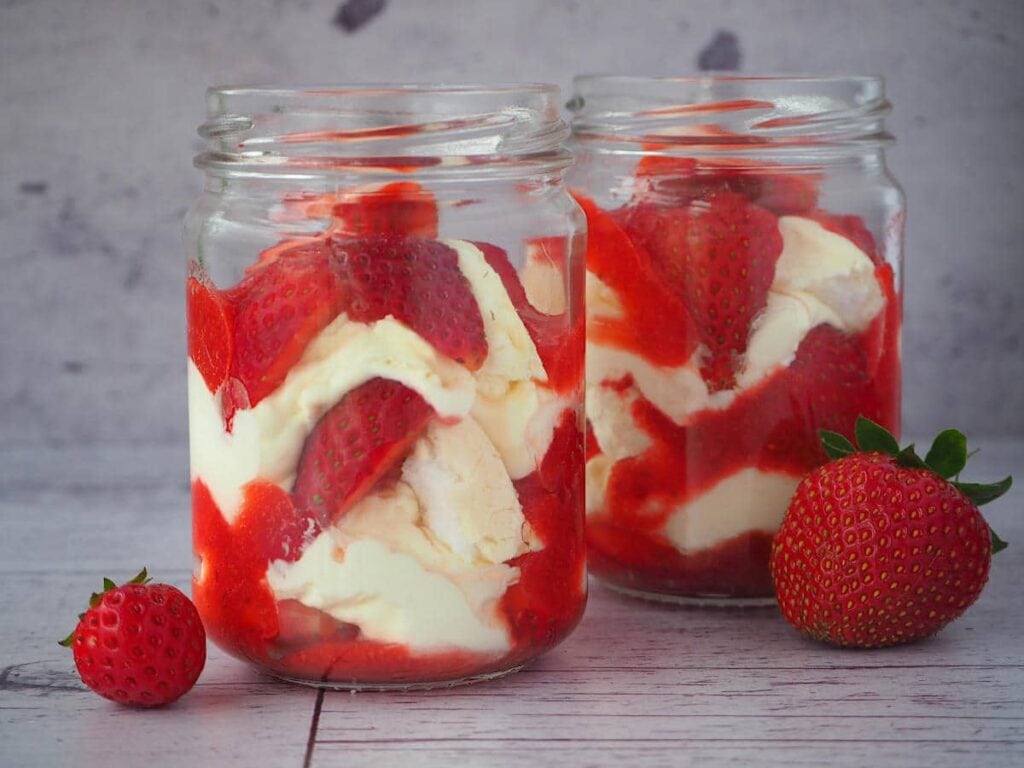
Chelsea buns
A yeast-risen dough that is flavoured with lemon peel, cinnamon and mixed spice. Drizzled with a glace icing these taste kind of like cinnamon buns.
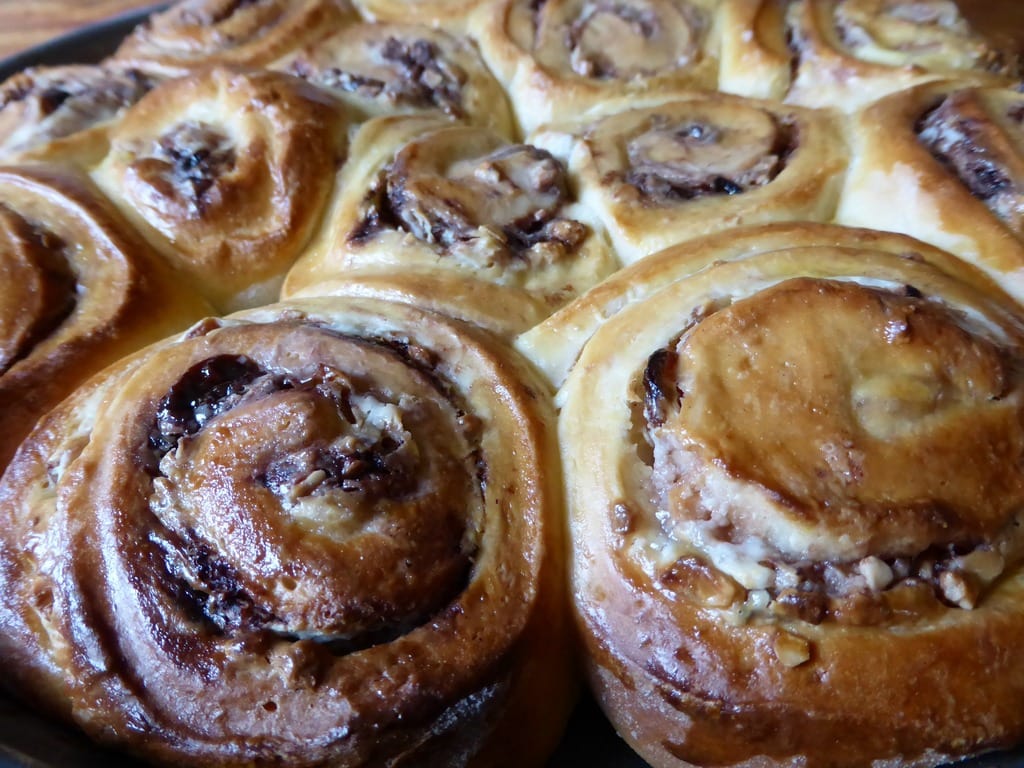
Melton Mowbray pork pie
Made from chopped or minced pork often combined with bacon and put in a hand-raised pastry crust. The pie is named after its place of origin Melton Mowbray, a town in Leicestershire. The original bakery of these in Melton Mowbray churns out 30,000 of these little beauties at Christmas time.

Bakewell tart
A perennial English favourite is simply a small tart with layers of frangipane (an almond-flavoured filling) with jam on top and flaked almonds. It is always topped with a glacé cherry.
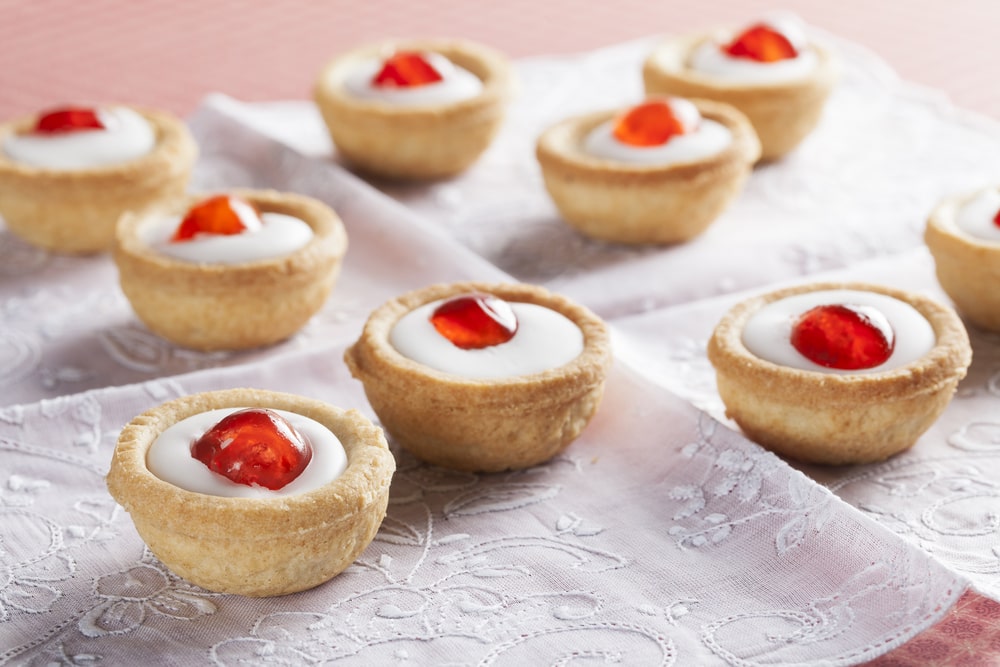
Bedfordshire clanger
A handheld pie like a sausage roll but with a savoury filling on one end and a sweet filling on the other. The perfect lunch pie.
Lancashire hotpot
A classic British savoury treat the Lancashire Hotpot is slow-cooked lamb stew with a mix of seasonal vegetables and covered in sliced potatoes. Cooked low and slow to tenderize the meat.

Cumberland sausages
Well known throughout England and available in many farmer’s markets and made from heritage pork. The Cumberland is quite peppery but very tasty. It used to be found in flat circular coils but these days you can easily find a regular sausage shape.
Eccles cake
Basically, a flaky pastry shell packed with sweet fruits, currants, and raisins and sprinkled with sugar.
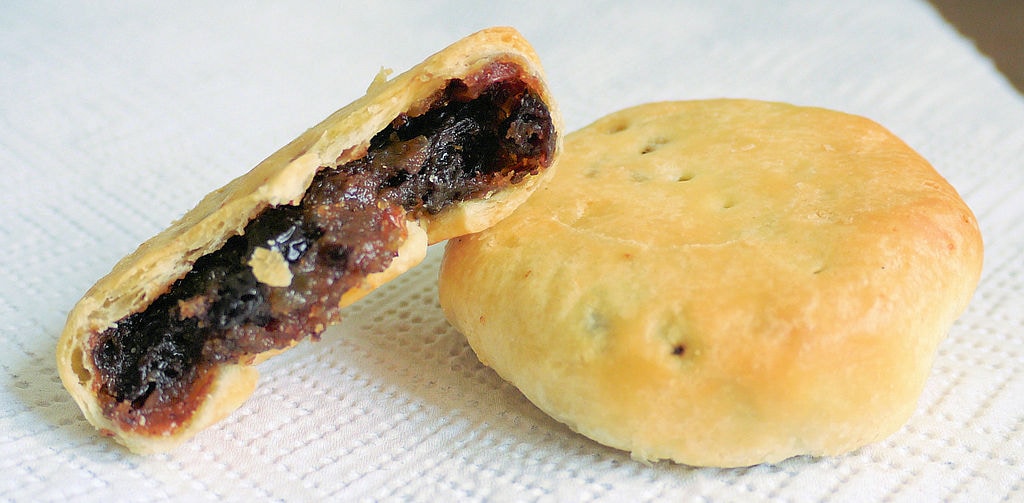
Cornish pasties
Everybody’s favourite handheld pie. Shortcrust pastry encloses ground beef, onions small diced potatoes and seasoning including lots of pepper. It should be according to the pros 12.5% beef and 25% vegetables.
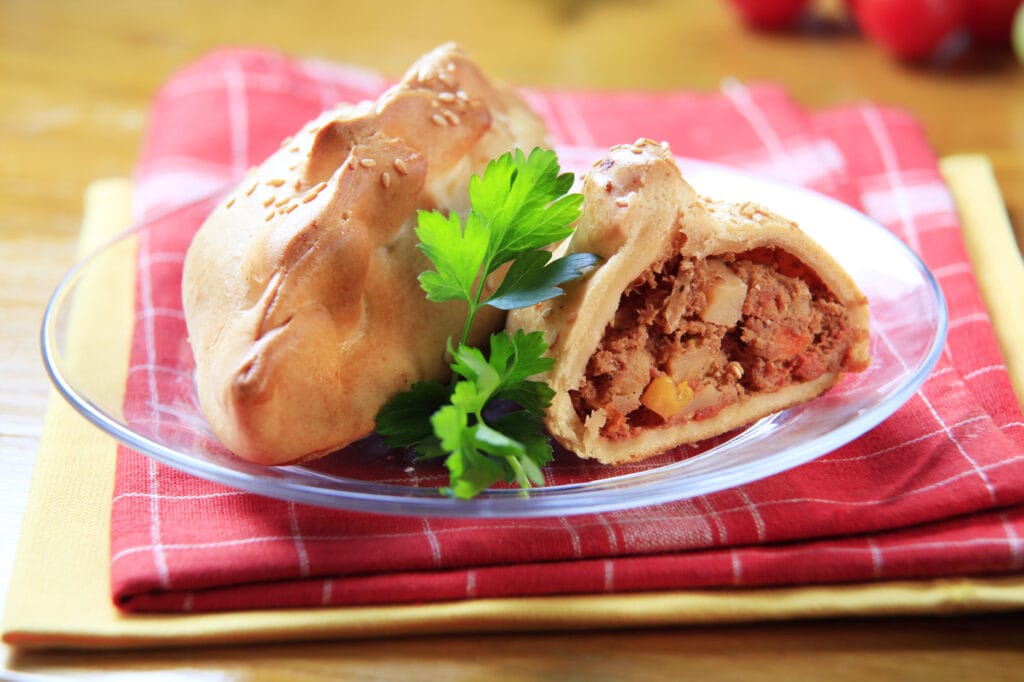
Read about the History of the Cornish Pasty here
That traditional Cornish food the Pasty is a thing of beauty and incredibly flavourful given it only contains salt and pepper as seasonings but oh you can’t resist it – trust me.

Hog’s pudding
Hog’s pudding is a type of sausage. There are different recipes and ingredients but usually, it is made of pork meat and fat, suet, bread, and oatmeal.
Maids of Honour tart
A traditional tart filled with cheese curds but you can find different variations some with jam which would seem to me to be a much better tart.

The Maids of Honour Tart has been part of Richmond’s history for nearly 300 years. It is believed that Henry VIII was the first to use its name when he met Ann Boleyn and other Maids Of Honour at his Royal Household of Richmond Palace eating the cakes from a silver dish.
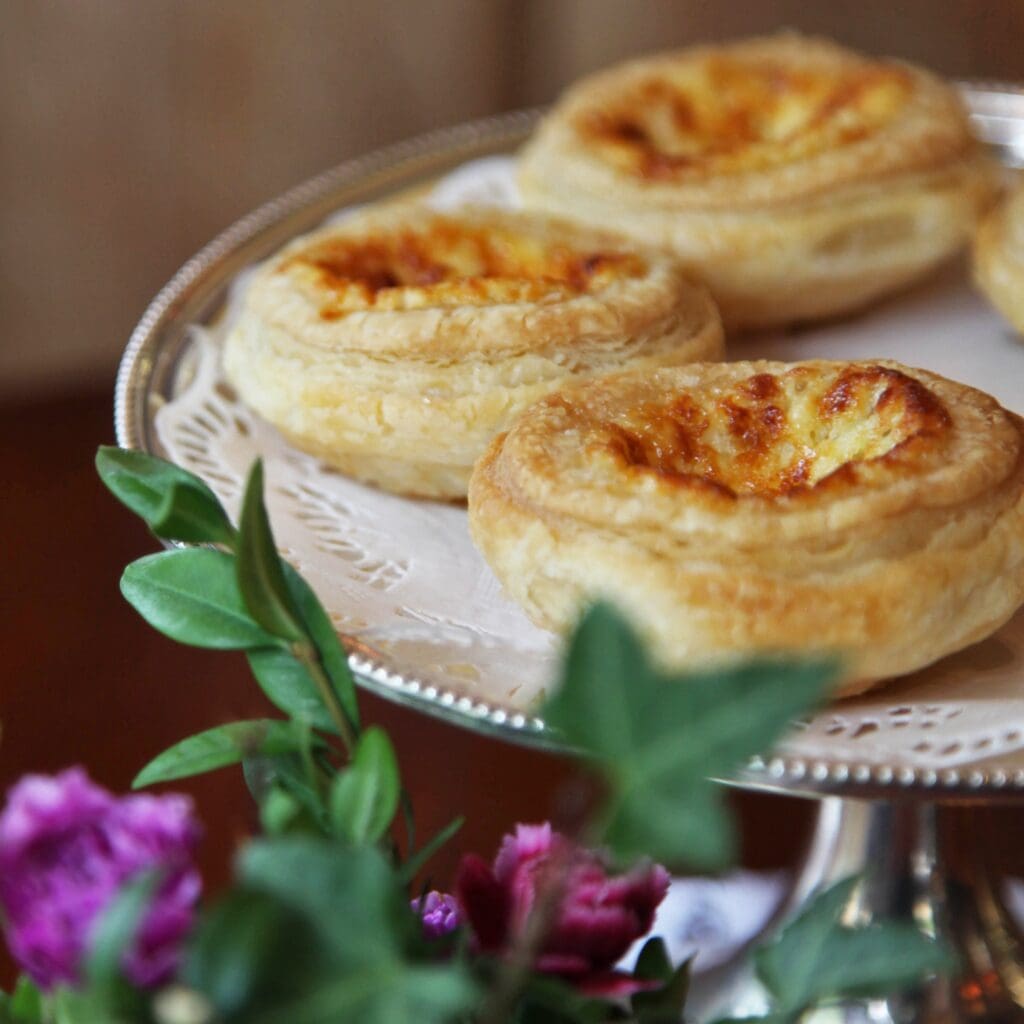
The first Richmond Maids of Honour shop can be traced back to the early 18th Century and it is here Robert Newens, the grandfather, served his apprenticeship. The cakes soon became a feature of taking tea in fashionable Richmond.
In 1850 Robert Newens continued the tradition of selling and making Maids Of Honour Tarts and in 1860 moved his shop to Kew where it can still be found to this day. The current family owners have maintained this tradition and continue to serve their long-standing speciality “Maids Of Honour”.
Coventry God cakes
This is usually given by godparents to their godchildren at New Year. It is a triangular piece of puff pastry filled with currants, cinnamon, nutmeg, candied fruit peel and sugar and dusted with sugar.
Staffordshire oatcakes
A crepe-like pancake made using oatmeal, flour and yeast which gives it a rather dense texture. They are particularly good stuff with breakfast items like eggs and bacon. These remind me of the French galette a buckwheat pancake used for savoury dishes in Brittany.

Pease pudding
Sort of like mushy peas but made with split yellow peas cooked in a broth or stock for around an hour. The peas meltdown making a sort of puree. This is usually served with bacon or ham.
Panackelt
This is a slow-cooked casserole dish containing root vegetables like carrots, turnips, onions, parsnips and potatoes a true one-pot meal from the Northeast of England.

Parkin or Perkin cake
gingerbread cake made with oatmeal and black treacle. Once the cake is out of the oven and resting it becomes moist and sticky and delicious served with a good old Bird’s custard.
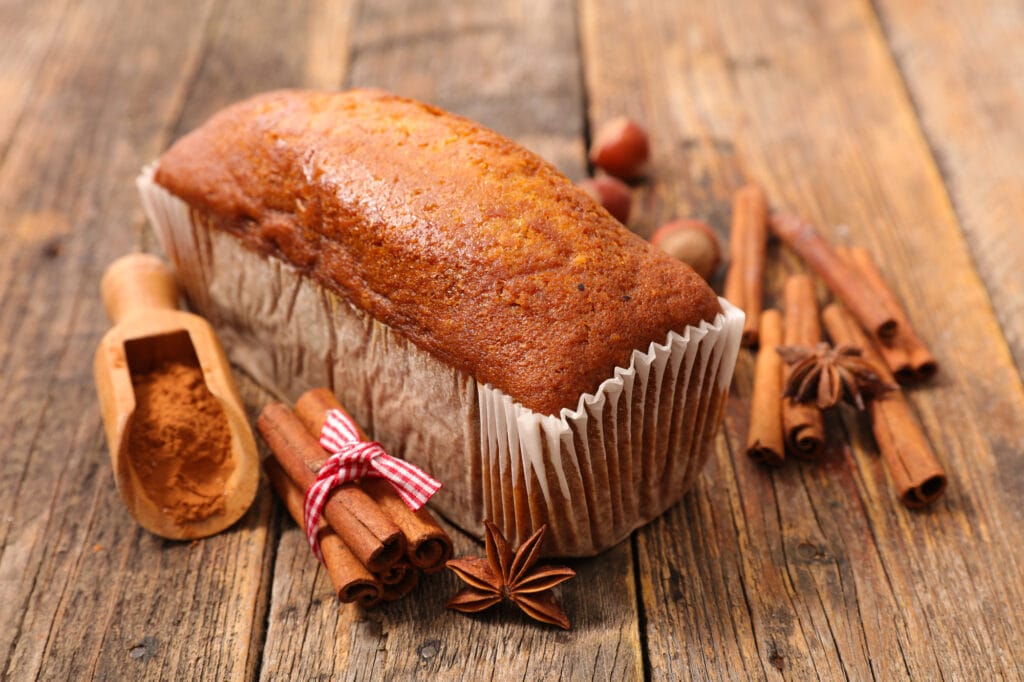
Potted shrimp
Tiny little brown shrimp that are seasoned with nutmeg, butter and salt are then placed in a pot, the pot is then topped with melted butter which hardens and acts as a preservative for the shrimp.
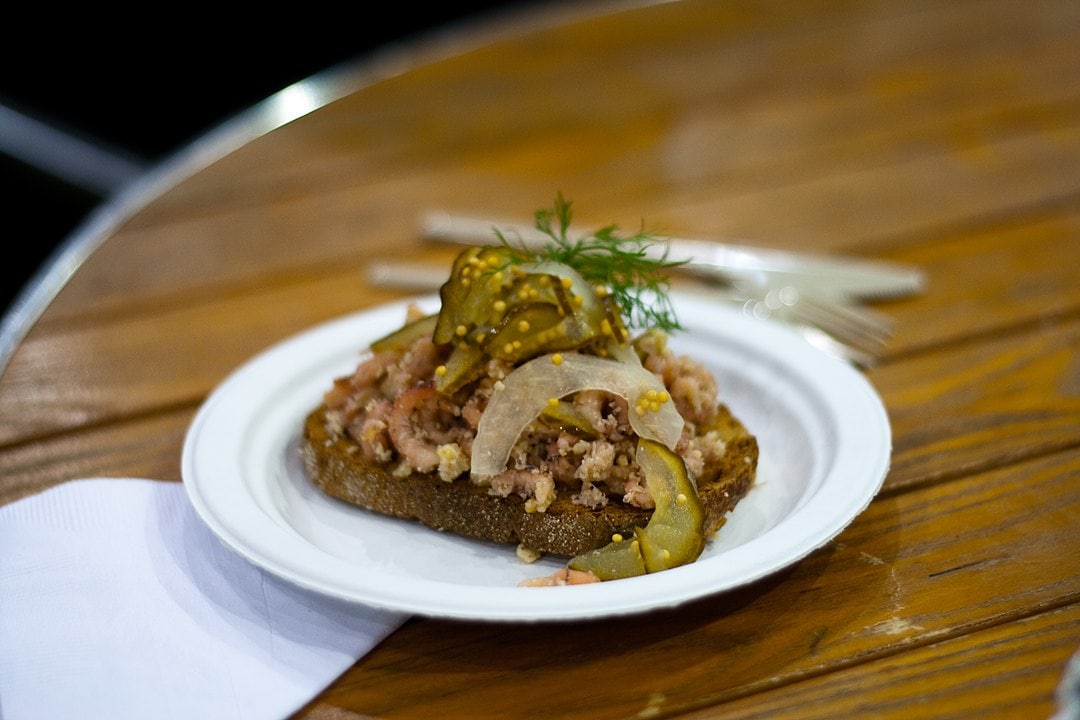
Rag pudding
Another of those fabulous English puds comes from the Manchester area. It’s a savoury pudding with ground beef and onions wrapped up inside a suet-based pastry. This is then put in cheesecloth and boiled for hours before serving.
Stargazy pie
Everyone has heard of Stargazy pie and the famous story surrounding its invention. It was a pie born of famine in Cornwall when a fisherman braved the cold December waters to make sure Mousehole folk didn’t starve. Made from sardines or pilchards in cream with lots of salt and pepper and some boiled eggs. The sardines poke out of the flaky pastry crust “gazing” at the sky.
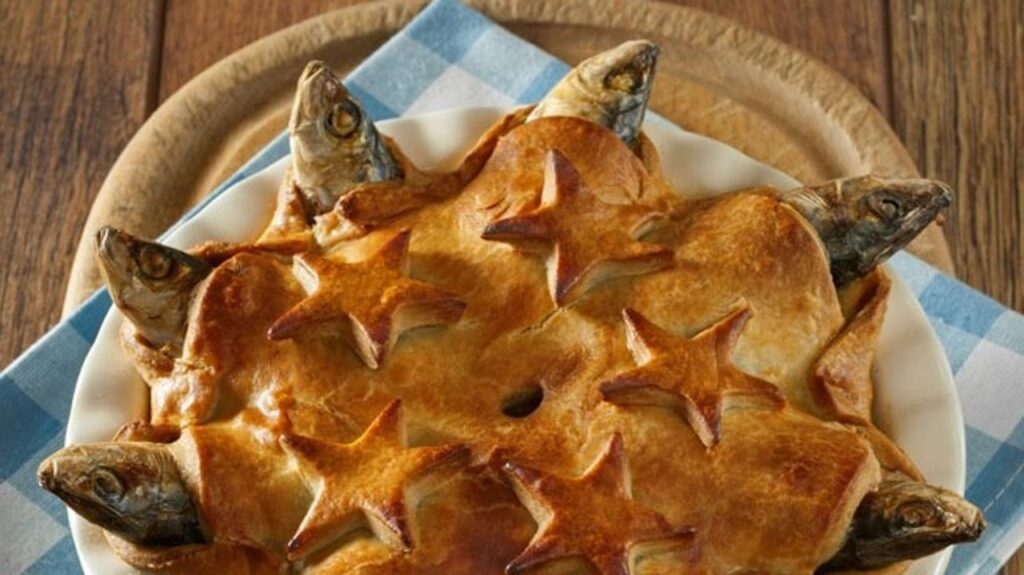
Bubble and squeak
What can I say about my favourite leftovers? Bubble and Squeak is supposed to be potatoes and cabbage and gets its name from the “squeak” made from the cabbage as it fries. My mum always made it with Sunday dinner leftovers so turnip, potatoes, carrots, Brussels, onions and tiny bits of Sunday roast.
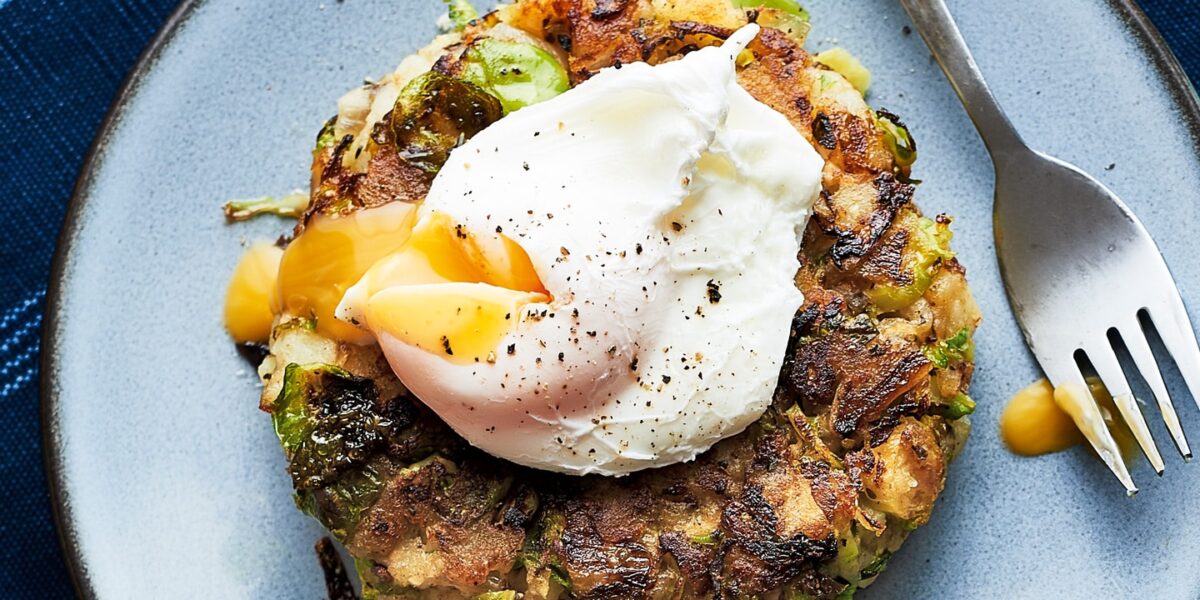
Faggots
Basically, a meatball made from ground pork and other bits of liver, heart and belly meat mixed up with some herbs, salt and pepper. Faggots are traditional in the English Midlands.
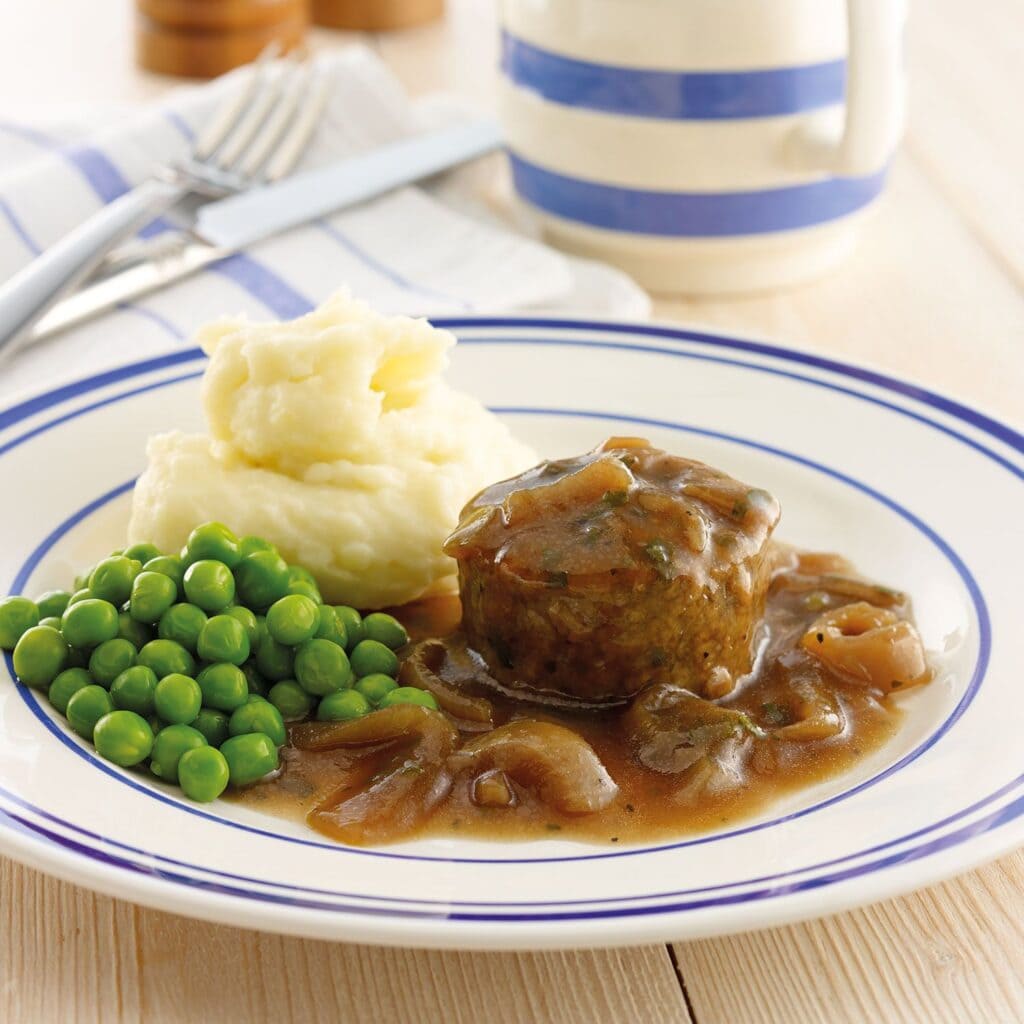
Kippers
We do love a kipper for breakfast at our house. These are herrings that have been butterflied and then cold smoked for four hours. The end result is a yellow fish that is the perfect ingredient for a kedgeree or served with a pat of butter in a full English breakfast.

Lincolnshire sausage
Another heritage-type sausage that has loads of sage in it. They are a thick sausage as the meat isn’t minced but simply coarsely ground. Obviously a favourite in Lincoln and Lincolnshire.

Ploughman’s
A cold selection of bread, cheese, pickled onions and raw onions, with some cold meats and of course Branston Pickle. The bread is white and crusty and good English butter is served with it. You will find these in pubs and cafes and they make a great light lunch.
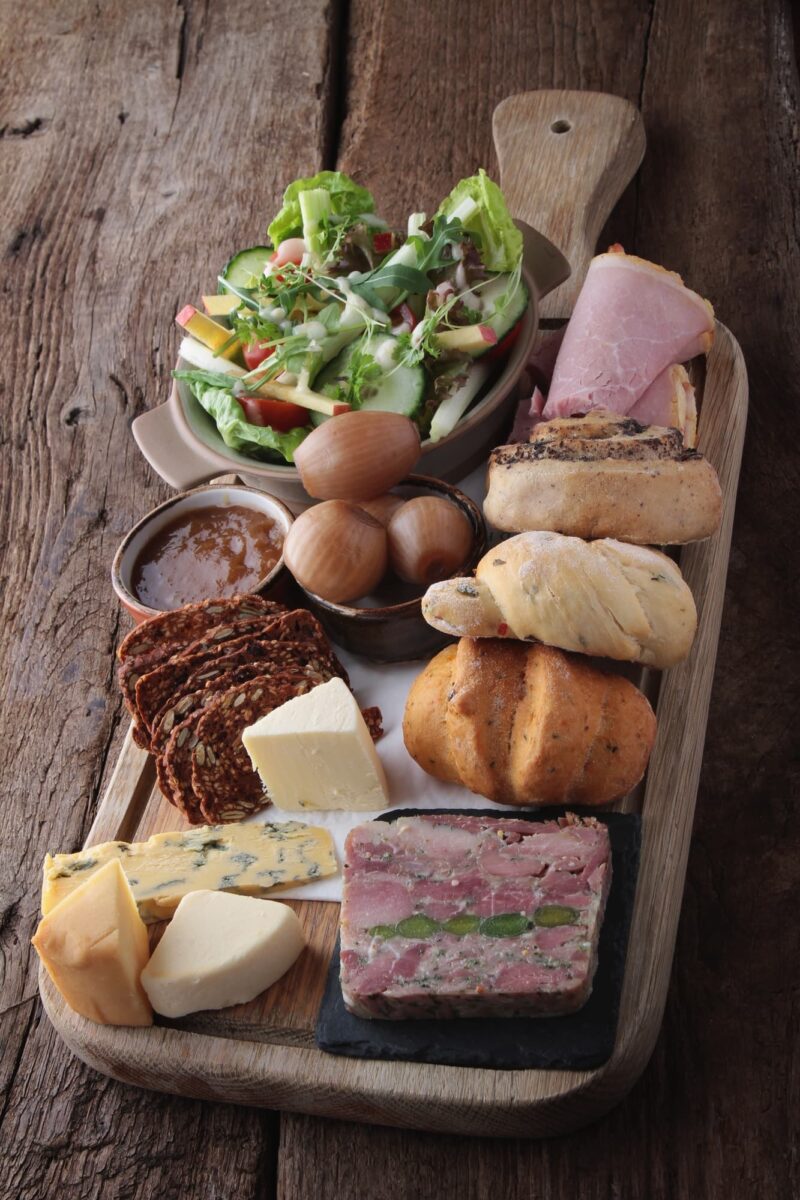
Scouse
A Liverpool stew of root vegetables and lamb or beef. Served in pubs and it was the choice food of sailors as it is cheap and filling. Sensing a theme here with these English pies?

Battenberg Cake
A light sponge cake that has been coloured usually pink and yellow then cut into long square pieces and layered into a checkerboard pattern. It is then covered in marzipan and served sliced at a High Tea so you can see the pattern.
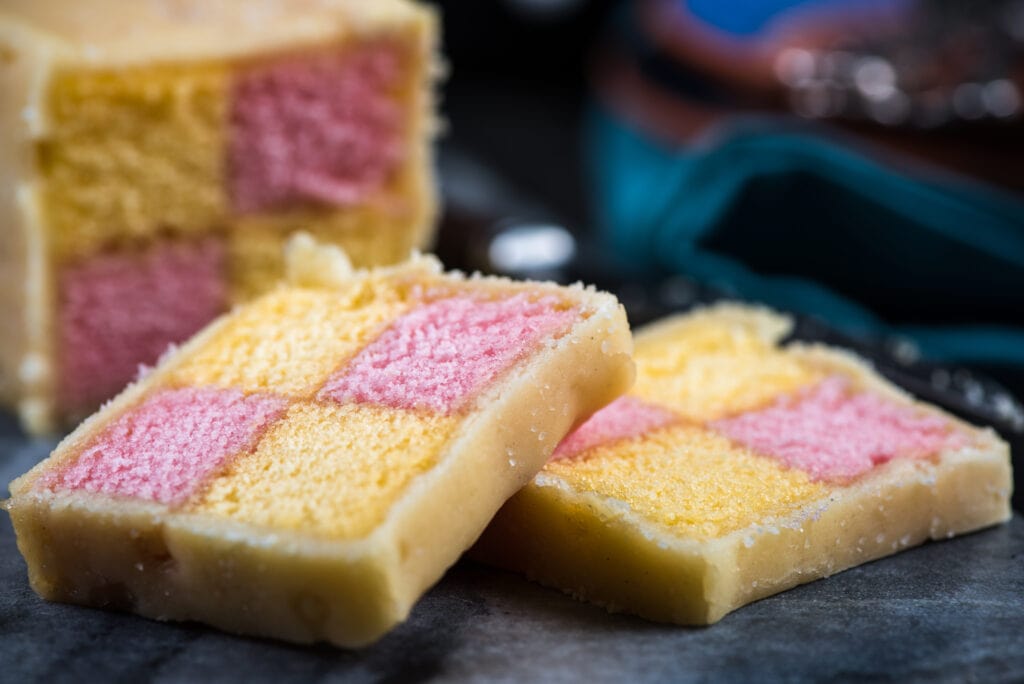
Gypsy tart
From Kent, this little pie’s filling is made from evaporated milk, muscovado (dark brown) sugar and a shortcrust pastry. It is teeth achingly sweet and made even sweeter when condensed milk is used.
Heavy cake or Hevva cake
A traditional cornish cake made with flour, lard and milk and studded with raisins with sugar on top. Called a heavy cake since it is not yeast-raised.
Jam roly-poly
Everybody loves a jam roly-poly. Traditionally this is a suet pudding with is spread with jam and then rolled up and served sprinkled with icing sugar.
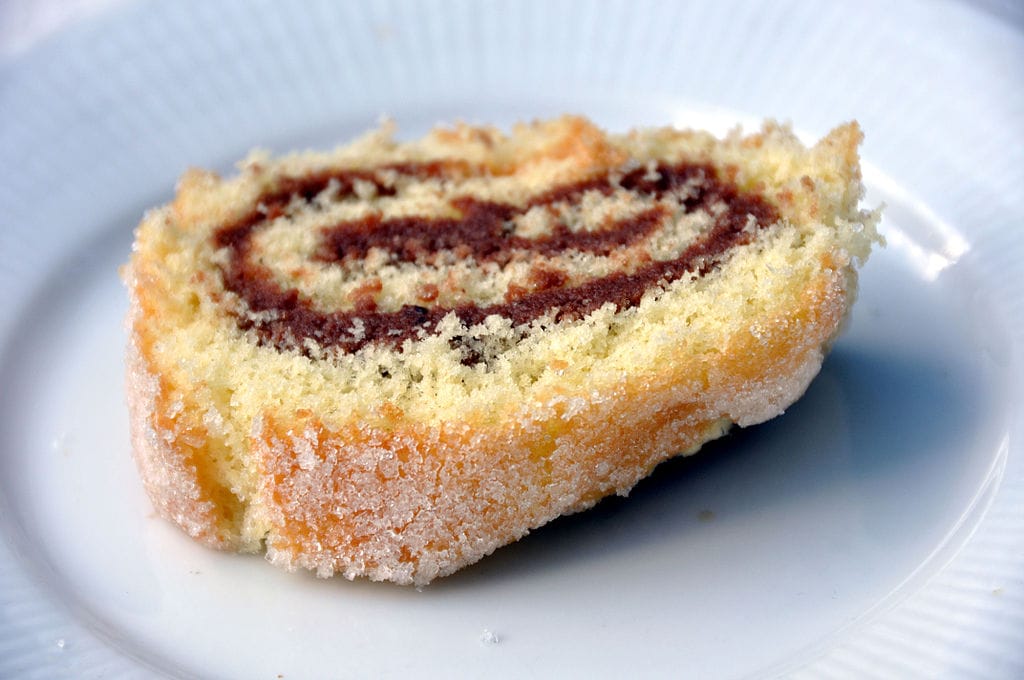
Lardy Cake
Also known as Dough Cake or Lardy Bread this is from the southern counties of England and is an egg-enriched yeasted dough like bread but with spices and raisins in it.
Saffron bun
A deep yellow Cornish bun that is made with a spiced yeast dough coloured with saffron. The bun is flavoured with cinnamon and nutmeg and traditionally contains currants and sultanas.
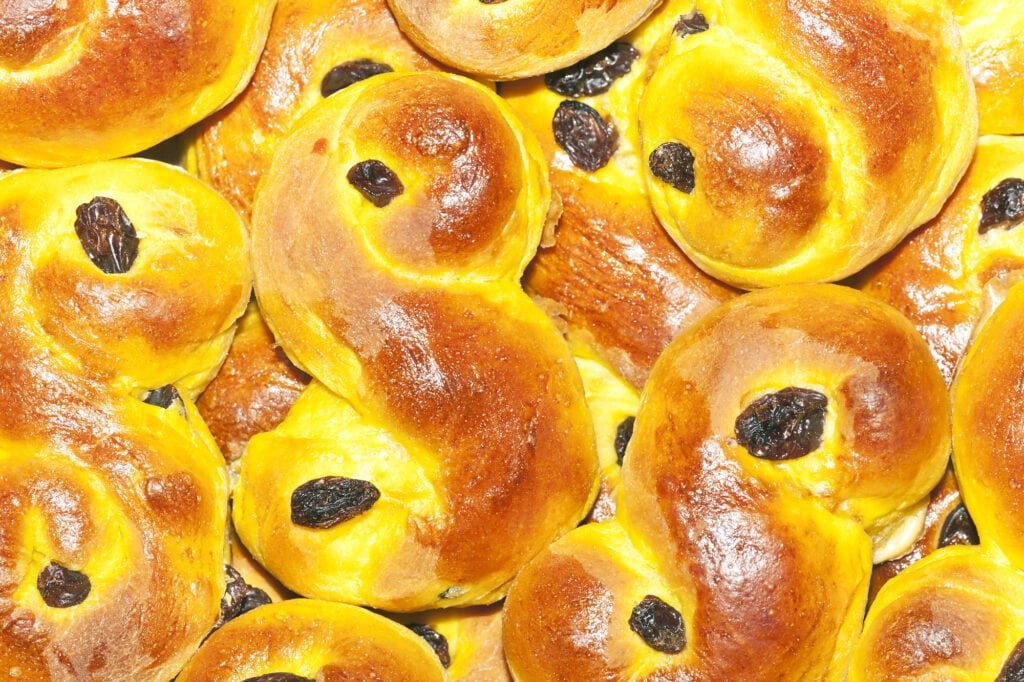
British Chocolate
Last but never least is British chocolate. Who can resist a Fry’s Cream bar or a Flakey perhaps a Yorkie? The best British chocolate brands give us chocolate that simply melts in your mouth and tastes so good you will have to sample them all to find your favourite – it’s a hard job but well worth doing right.

It goes without saying that everyone who loves meat enjoys a Sunday Roast meat dinner and of course a Full English breakfast I should definitely mention that some of the best Food Halls I have ever visited with a superb selection of products to enjoy are available in London- foodies should all visit at least once in their lives.
If you want to taste some of these traditional English food favourites you should head to Leather Lane Market or Borough market for some truly great British food. Recent modern British cuisine is now the darling of food tourism and you will find some of the greatest Chefs in the world in London and the rest of Great Britain.
Do you have a favourite British food?
You might also like
The ultimate guide to coffee around the world – 33 coffee traditions and rituals
148 National Dishes of countries around the world
17 of the Most Unusual Foods Around the World | Weird Food
Scottish foods – 53 Scottish favourites
